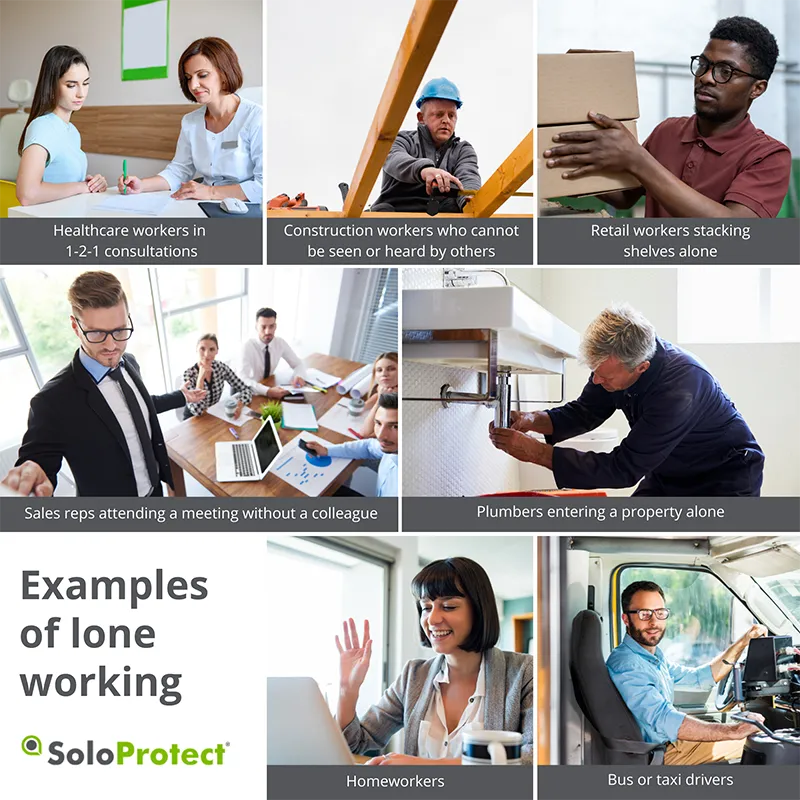What is a lone worker?
What is the definition of "lone working"? Who qualifies as a lone worker? How prevalent is lone working? Are lone workers adequately protected? We address your queries...

At SoloProtect, we're regularly asked questions such as:
- What is meant by "lone working"?
- Who falls under the category of lone workers?
- Does working from home qualify as lone working?
- Is lone working compliant with the law?
- What measures can I take to safeguard my lone workers?
- And many, many more.
So we've provided some answers below.
If you have any other questions, please contact us and we would be happy to help.
What is a lone worker?
The Occupational Safety and Health Administration (OSHA) defines lone workers as “an employee working alone, such as in a confined space or isolated location”.
What is classed as lone working?
Ultimately, if an employee cannot be seen or heard by a colleague, they are classified as a lone worker (regardless of whether this occurs all or some of the time). It’s particularly important not to overlook lone workers who:
- Work in the community with members of the public.
- Travel during work hours.
- Work on the same site or in the same building as their colleagues but cannot always be seen or heard by any of them.
- Are alone only when their colleague(s) take a break.
- Work late and are therefore the last to remain in the workplace.
- Work in busy populated areas such as city centers or stadiums.
- Work from home or from another location.
Is home working an example of lone working?
Home-based workers should also be classified as lone workers because they work independently, without the proximity of colleagues. Therefore, it's important to prioritize their safety and well-being.
Click this link for more information about Ensuring Lone Worker Safety: Protecting Your Most Valuable Assets
Lone working examples
- A plumber entering someone’s property alone.
- A retail worker stacking shelves with no other colleagues in the direct vicinity.
- A healthcare worker in a one-on-one consultation.
- Homeworkers.
- A sales representative attending a meeting without a colleague.
- Bus and delivery drivers.
- A construction worker in a location where they cannot be seen or heard.
- Teachers without another colleague in the classroom.
- A realtor conducting an open house or showing a property alone.
- Nurses providing home health care services, visiting patients in their homes without immediate colleague support.

Is it legal and safe to be a lone worker in the US?
Lone workers face heightened risks due to the absence of colleagues who can assist in case of an incident. These incidents could arise from social risks like violence or aggression, or environmental risks such as slips, trips, and falls.
However, in the United States, working alone is legal and can be safe. Nevertheless, employers must be mindful of their health and safety obligations towards lone workers, as outlined by regulatory bodies like OSHA (Occupational Safety and Health Administration).
What is lone working health and safety?
Employers hold the responsibility for ensuring the health and safety of their lone, remote, and home-based workers. This means it's vital for employers to conduct thorough risk assessments before allowing anyone to work alone. Such assessments involve identifying potential hazards and implementing appropriate control measures and safeguards to minimize risks effectively.
You may find these pages useful:
• Lone Worker Risk Assessment Template
Protecting Your Lone Workers
For many organizations that employ lone workers, one of these safeguarding measures is a lone worker solution that helps to protect lone workers from risk. It ensures the fastest possible emergency response should an incident occur and provides workers with peace of mind that someone will be on hand to support them should they need it. Consider exploring SoloProtect's range of lone worker devices for comprehensive protection and peace of mind. Learn more about SoloProtect solutions here.
Your message has been received and we will be in touch shortly.









.jpg)
.jpg)
.jpg)







